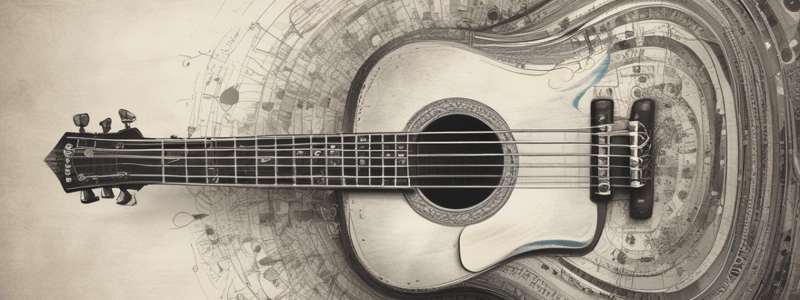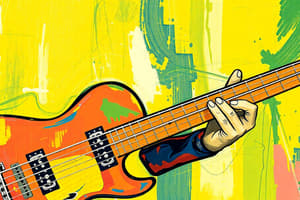Podcast
Questions and Answers
What is the purpose of pitch pipes in guitar tuning?
What is the purpose of pitch pipes in guitar tuning?
- To replace old or damaged strings
- To inspect the guitar for any damages
- To detect string pitch using the device's microphone
- To provide a standard pitch for tuning by ear (correct)
What is the first step in the standard guitar tuning process?
What is the first step in the standard guitar tuning process?
- Double check each string and ensure none slipped during the process
- Tune the A string
- Tune the G string
- Pluck the low E string and use a tuner to adjust the pitch to E (correct)
Why do strings often slip out of tune during the tuning process?
Why do strings often slip out of tune during the tuning process?
- Due to uneven fret wear
- Due to environmental factors like temperature and humidity changes
- Due to worn-out strings or loose tuning pegs (correct)
- Due to improper string height
What is the long-term solution to prevent tuning issues caused by environmental changes?
What is the long-term solution to prevent tuning issues caused by environmental changes?
What is the correct sequence of tuning the strings in standard guitar tuning?
What is the correct sequence of tuning the strings in standard guitar tuning?
What is the best guitar tuning method for beginners?
What is the best guitar tuning method for beginners?
What is the purpose of lubricating the nut slots and saddle?
What is the purpose of lubricating the nut slots and saddle?
What is the common issue that results from improper string height, incorrect neck alignment, or uneven fret wear?
What is the common issue that results from improper string height, incorrect neck alignment, or uneven fret wear?
What is the purpose of using a tuner fork in guitar tuning?
What is the purpose of using a tuner fork in guitar tuning?
How do you tune a guitar by ear for beginners?
How do you tune a guitar by ear for beginners?
What is the primary purpose of guitar tuning?
What is the primary purpose of guitar tuning?
What is the standard tuning for a six-string guitar?
What is the standard tuning for a six-string guitar?
Why is regular tuning important for a guitar?
Why is regular tuning important for a guitar?
What type of tuner is commonly used by electric guitarists?
What type of tuner is commonly used by electric guitarists?
What happens if a guitar is out of tune?
What happens if a guitar is out of tune?
What is the benefit of using a tuner when tuning a guitar?
What is the benefit of using a tuner when tuning a guitar?
What type of tuner attaches to the guitar's headstock?
What type of tuner attaches to the guitar's headstock?
Why is tuning essential for guitar players?
Why is tuning essential for guitar players?
Flashcards are hidden until you start studying
Study Notes
Guitar Tuning Basics
- Guitar tuning is the process of adjusting string tension to produce the correct pitch.
- Standard tuning for a 6-string guitar is E-A-D-G-B-E, creating a harmonious and balanced sound.
- Proper tuning ensures correct notes, harmony with other instruments, and accurate solo performances.
Importance of Tuning
- Tuning is crucial for sound quality and playing chords/melodies accurately.
- It maintains the instrument's condition and extends string lifespan.
Tools for Tuning
- Clip-on Tuners: Attach to the headstock, detecting vibrations for precise tuning.
- Pedal Tuners: Integrated into a pedalboard, offering high accuracy and visibility.
- App-based Tuners: Smartphone apps using the device's microphone to detect string pitch.
- Pitch Pipes: Traditional tool producing reference tones for each string, useful for ear training.
- Tuning Forks: Providing a standard pitch (usually A440) for tuning by ear.
Step-by-Step Tuning Guide
- Prepare the guitar: inspect, ensure tuning pegs function properly, and check string condition.
- Standard tuning process:
- Start with the low E string, pluck, and adjust the pitch to E.
- Tune the A, G, B, and high E strings, following the same process.
- Double-check each string to ensure none slipped during the process.
Common Tuning Problems and Solutions
- Common issues: strings slipping out of tune, poor intonation.
- Causes: worn-out strings, loose tuning pegs, improper string height, incorrect neck alignment, uneven fret wear, environmental changes.
- Quick fixes: regularly check and tighten loose tuning pegs, replace old strings, lubricate nut slots and saddle.
- Long-term solutions: ensure proper guitar setup, maintain frets, store guitar in a stable environment.
Studying That Suits You
Use AI to generate personalized quizzes and flashcards to suit your learning preferences.




